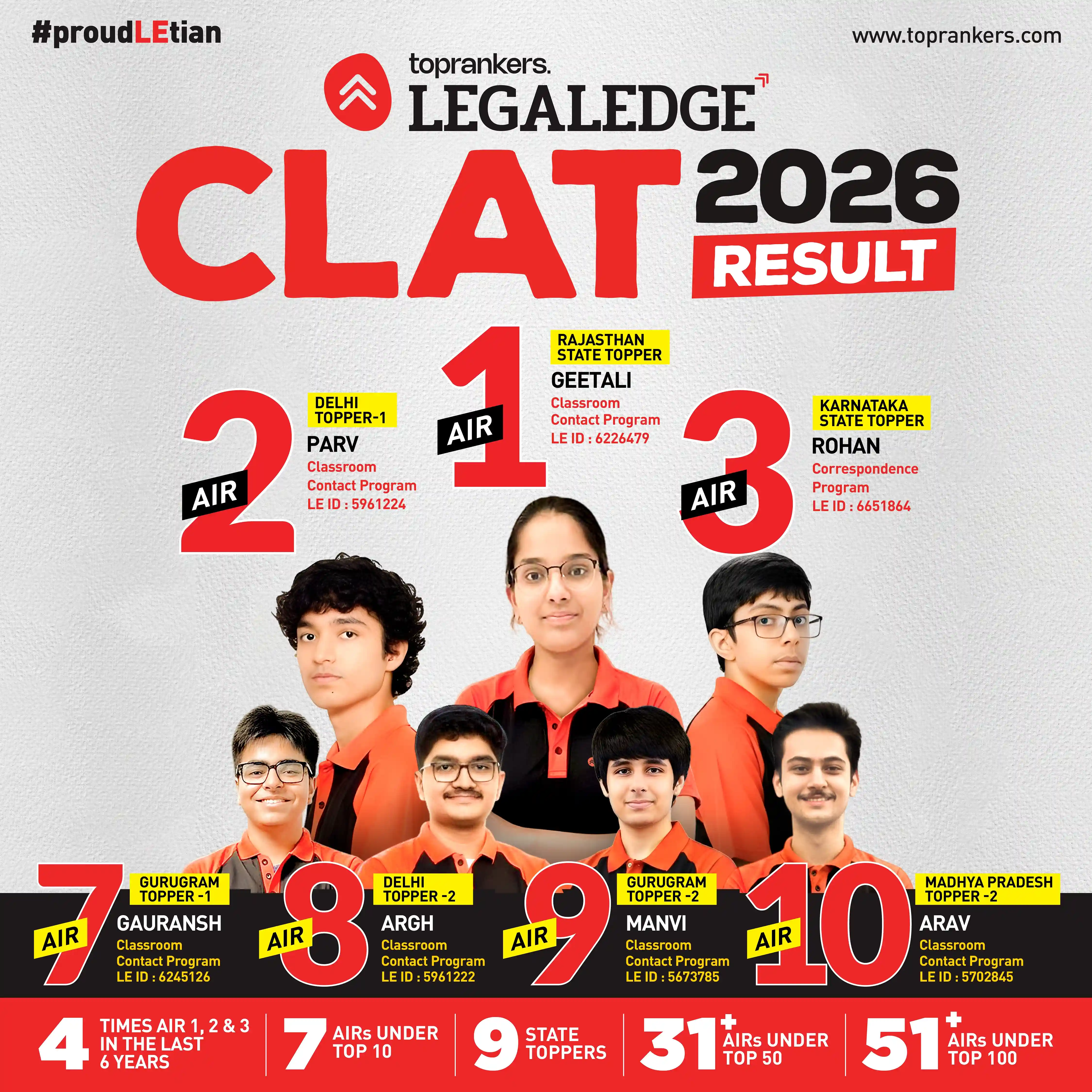Learnings from Official CLAT Legal Reasoning Sample Paper
December 26, 2025
Reader's Digest: Get a head start on CLAT Legal Reasoning! Learn from the Official Sample Paper and excel in the exam! 📚✍️
Looking for learnings from official CLAT Legal Reasoning Sample Paper? Get here! The Legal Reasoning section in the Common Law Admission Test plays a crucial role in assessing your ability to analyze legal situations and apply principles to practical scenarios.
In this section, you will encounter passages, each around 450 words long, covering legal matters, public policy questions, and moral philosophical inquiries. While no prior legal knowledge is required, a general awareness of contemporary legal and moral issues will aid in understanding and applying the principles discussed.
Remember, the CLAT pattern has changed! With the number of questions reduced from 35-29 to 28-32, every question counts! The weightage remains the same, that is, 25% of the total paper.
Let's explore the key learnings from Official CLAT Legal Reasoning Sample Paper to excel in this section:
- Understanding the Legal Reasoning section in CLAT
- Analysis of past CLAT papers [2023, 2022, 2021]
- Key Learnings from the Passages
Understanding the CLAT Legal Reasoning Sample Paper
Want to solve the Legal Reasoning questions like a pro? Let's dissect the Official CLAT Legal Reasoning Sample Paper to unveil key insights and master this critical section!
Explaining the Legal Reasoning Section's Format and Structure
The Legal Reasoning section evaluates your ability to analyze legal principles, apply them to practical scenarios, and arrive at sound conclusions. This section typically comprises legal passages or scenarios, followed by questions that demand thoughtful responses based on your legal knowledge and analytical skills. 🔍
Role of Reading Comprehension and Critical Thinking
To excel in Legal Reasoning, reading comprehension is your superpower! By understanding legal passages thoroughly, you can grasp the nuances of each situation. Critical thinking comes into play as you critically analyze the information and make well-reasoned judgments. 💭
Emphasis on the Ability to Apply Legal Principles
In this section, your ability to apply legal principles to practical scenarios takes center stage! Be ready to identify legal issues, deduce relevant laws, and apply them effectively to draw accurate conclusions. This skill is crucial for aspiring lawyers and law professionals! 💼
Analysis of CLAT Legal Reasoning Sample Paper
Going through the CLAT Exam Analysis of the previous year's question papers will help you analyze the difficulty level and the type of questions asked in the exam.
To make it easier, we have analyzed the last three years' question papers:
| CLAT 2021 | CLAT 2022 | CLAT 2023 |
| Volenti Non Fit Injuria (Ratanlal-Dhirajlal) | Writ-Mandamus | Surrogacy |
| Consent under ICA (Lawctopus) | Constitution - state duty of levy of taxes | NALSA |
| Communication, when complete under ICA | Constitution - Fundamental right and reasonable restriction | Electoral Bond Scheme |
| Agreements in restraint of legal proceedings | Family law - Bigamy | Criminal Law Procedure |
| Res Judicata | Special Marriage Act | Civil Law Procedure |
| Compassionate Appointment (Free Press Journal) | International law - Monism and Dualism | Consumer Protection Law |
| General Article on Hindu Marriage Act | Sustainable Development | Indian Penal Court [Section 498A & Section 69A] |
| Consent under fear under ICA | Contract - Mistake of Fact | Constitution [Internet Shutdown] |
5 Key Learnings from Official CLAT Legal Reasoning Sample Paper
Here, we have discussed some learnings from the sample papers which will help enhance your CLAT Legal Reasoning Preparation and score well in the upcoming exam.
Inferring Rules & Principles from the Passages
When tackling the CLAT Legal Reasoning passages, it's crucial to identify the underlying rules and principles embedded within the text. These passages often contain valuable insights into legal concepts, essential for correctly answering the associated questions.
To master this skill, focus on understanding the context and nuances presented in the passages. Look for clear and direct statements that establish rules and principles. Pay attention to phrases like "it follows that," "therefore," or "in accordance with," as they indicate the presence of rules.
Let's consider an example:
Passage: "Every individual has the right to freedom of speech, but this right may be limited in cases of hate speech that incites violence."
Associated Rule/Principle: "Freedom of speech is a fundamental right, but it can be restricted in cases of hate speech leading to violence."
Read Question Stem
When you encounter a question in the Official CLAT Legal Reasoning Sample Paper, analysing the question stem can make all the difference. Let's create a simple table to help you organize your thoughts and approach the questions systematically:
| Type of Question | What to Determine | Key Focus |
|---|---|---|
| True or False | Determine if the statement is true or false. | Focus on the accuracy of the statement. |
| Person's Liability | Assess whether the person is liable for actions. | Pay attention to their responsibility. |
| Person's Conviction | Evaluate if the person should be convicted. | Examine the possibility of their guilt. |
| Other Specific Query | Identify the specific legal query in question. | Pinpoint the core issue for resolution. |
By categorizing the types of questions and their respective focus, you'll be better prepared to tackle each one with precision.
Read More: Critical Reasoning Questions for CLAT 2025
Applying Rules & Principles to Fact Situations
Applying legal concepts to practical situations demands reasoning and logical thinking. As you encounter fact situations in CLAT Legal Reasoning, here's a step-by-step approach to excel in this aspect:
- Analyze the Fact Situation: Carefully read and understand the given scenario. Identify the legal issues involved and the relevant rules and principles you've inferred from the passages.
- Match Rules to Facts: Draw parallels between the identified rules and the facts presented in the scenario. Focus on how the rules apply to the specific situation at hand.
- Consider Exceptions and Conditions: Be mindful of any exceptions or conditions that might modify the application of the rules. These subtleties are vital in determining the outcome of the scenario.
- Formulate a Coherent Argument: Articulate your reasoning logically and coherently. Support your conclusions with references to the applicable rules and explain how they align with the given facts.
Illustrative Example:
Fact Situation: "A person intentionally caused harm to another during an altercation."
Identified Rule: "An intentional act that causes harm to another constitutes battery."
Application: By matching the identified rule to the fact situation, we can conclude that the person's actions fall under the legal definition of battery.
Read Editorials to Resonate with CLAT Legal Reasoning Questions
When it comes to mastering CLAT Legal Reasoning, knowing how to read newspapers for CLAT can be a valuable tool to enhance your understanding and analytical abilities. Let's explore a simple table to guide you on how to read editorials effectively and resonate with CLAT Legal Reasoning questions:
| Step | Explanation |
|---|---|
| 1. Select Reputable Editorials | Focus on editorials from credible newspapers and publications. These pieces often delve into legal issues and provide in-depth analysis. |
| 2. Grasp the Central Argument | Identify the main argument presented in the editorial. Understanding the core viewpoint is crucial for addressing legal questions. |
| 3. Spot Legal Implications | Pay close attention to any legal aspects discussed in the editorial. Observe how the author relates laws and principles to real-world scenarios. |
| 4. Assess Supporting Evidence | Look for evidence or examples provided to back the central argument. Evaluate how these align with legal principles and reasoning. |
| 5. Analyze Counterarguments | Engage with opposing viewpoints presented in the editorial. This exercise sharpens your ability to evaluate diverse perspectives. |
| 6. Relate to CLAT Legal Questions | Connect the editorial's insights to legal reasoning questions you've encountered. Practice applying the concepts to different scenarios. |
| 7. Discuss with Peers or Mentors | Engage in discussions about the editorial's content with fellow CLAT aspirants or mentors. Sharing perspectives can deepen your understanding. |
Conclusion
In conclusion, knowing the key learnings from Official CLAT Legal Reasoning Sample Paper is crucial for success in the exam. Here are the key takeaways:
- Through careful analysis of past CLAT papers, you can gain insights into question patterns and difficulty levels.
- The key learnings from the passages include inferring rules and principles, understanding question stems, and applying legal concepts to fact situations.
- Critical reading and logical thinking play a significant role in this section.
- Additionally, reading editorials enhances your understanding and analytical abilities.
- Remember, with the recent changes in the CLAT pattern, every question counts, so prepare thoroughly to excel in this critical section.
Frequently Asked Questions
How many questions will be asked in CLAT Legal Aptitude section?

What is the purpose of the Legal Reasoning section in the CLAT exam?

What topics are covered in the passages of the Official CLAT Legal Reasoning Sample Paper?

How can a general awareness of contemporary legal and moral issues benefit me in the Legal Reasoning section?

How to increase marks in CLAT Legal Reasoning section?

How can critical thinking play a role in excelling in the Legal Reasoning section?

What is a good score in CLAT Legal Reasoning Sample Paper (official)?

How can analyzing past CLAT papers help in preparation for the Legal Reasoning section?

Does Consortium release the Legal Reasoning Sample Paper every year?






SHARE